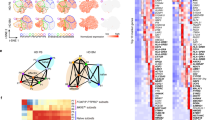Abstract.
Fork head box P3 (FoxP3+) regulatory T cells (Tregs) are specialized T cells for prevention of hyperimmune responses and autoimmunity. Tumors and pathogens can hijack FoxP3+ Tregs to evade host immune responses. There is an increasing body of evidence that trafficking of FoxP3+ Tregs is important for their effective suppression of target cells. Because of their distinctive functions and gene expression phenotype, the migratory behavior of FoxP3+ Tregs has been somewhat mystified. The myths are that they have unique trafficking receptors and migratory behaviors that are different from those of conventional T cells. Another related myth is that FoxP3+ regulatory T cell subsets have a fixed trafficking behavior from the time they are generated in the thymus. The recent progress in trafficking receptors and migratory behavior of FoxP3+ Tregs is reviewed here and the validity of these myths is examined.
Similar content being viewed by others
Abbreviations
- 2° LT:
-
secondary lymphoid tissues
- non-LT:
-
non-lymphoid tissues
- PP:
-
Peyer’s patches
- IPEX:
-
immunodeficiency polyendocrinopathy enteropathy X-linked syndrome
- Tregs:
-
regulatory T cells
- FoxP3:
-
Fork head box P3
- DP:
-
double positive
- SP:
-
single positive
Author information
Authors and Affiliations
Corresponding author
About this article
Cite this article
Kim, C.H. Trafficking of FoxP3+ regulatory T cells: myths and facts. Arch. Immunol. Ther. Exp. 55, 151–159 (2007). https://doi.org/10.1007/s00005-007-0024-8
Received:
Accepted:
Published:
Issue Date:
DOI: https://doi.org/10.1007/s00005-007-0024-8




